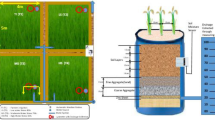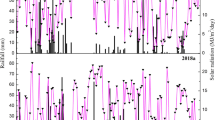Abstract
Rice production is one of the largest consumer of water in agriculture. In general, the irrigation water productivity (WPI) is low in paddy fields. In order to improve WPI, a field experiment was conducted in central of Iran during 2009–2010. The experiment was consisted of three irrigation managements and eight advanced rice cultivars (Gerdeh (V 1), Zayande-roud (V 2), Sazandegi (V 3), Hasani (V 4), 67–97 (V 5), 67–113 (V 6), 67–47 (V 7), and 67–72 (V 8)) in a split plot design with three replications. The irrigation treatments were I 1 and I 2: permanent flooding under 3.5 and 2.2 cm water depth, respectively, and I 3: 0–1.5 cm alternative wetting and drying. To explore deficit irrigation for improved WPI, SWAP model was calibrated using intensive measured data for the foregoing years. The average normalized root-mean-square deviation of yield during calibration was 0.03% and during validation was 4.94% indicating acceptable calibration and validation of the model. WPI for all cultivars were enhanced up to 61% by applying 50% deficit irrigation. On this irrigation regime, V 2 and V 6 provided the highest WPI (0.84 and 0.79 kg m−3, respectively) whereas V 4 and V 8 yielded the lowest (0.50 and 0.57 kg m−3, respectively). The results indicated that rice cultivars (V 2 and V 6) are the best option with the highest WPI in the irrigation district and calibrated model was able to effectively simulate the crop growth under water deficit conditions.







Similar content being viewed by others
References
Ahmadzadeh H, Morid S, Delavar M, Srinivasan R (2015) Using the SWAT model to assess the impacts of changing irrigation from surface to pressurized systems on water productivity and water saving in the Zarrineh Rud catchment. Agric Water Manag 10.1016/jagwat201510026
Allen RG, Pereira LS, Raes D, Smith M (1998) Crop evapotranspiration-guidelines for computing crop water requirements. FAO Irrigation and Drainage Paper 56, Rome, Italy, p 299
Amiri E, Rezaei M, Eyshi Rezaei E, Bannayan M (2014) valuation of Ceres-Rice, Aquacrop and Oryza 2000 models in simulation of rice yield response to different irrigation and nitrogen management strategies. J Plant Nutr 37:1749–1769
Bessembinder JJE, Leffelaar PA, Dhindwal AS, Ponsioen TC (2005) Which crop and which drop, and the scope for improvement of water productivity. Agric Water Manag 73:113–130
Braden H (1985) Ein energiehaushalts- und verdunstungsmodell for wasser und stoffhaushaltsuntersuchungen landwirtschaftlich genutzer Einzugsgebiete. Ittelungen Deutsche Bodenkundliche Geselschaft 42:294–299
Chen C, Wang E, Yu Q (2009) Modeling the effects of climate variability and water management on crop water productivity and water balance in the North China Plain. AgricWater Manage. doi:10.1016/jagwat200811012
Confalonieri R, Rosenmund A, Baruth B (2009) An improved model to simulate rice yield. Agron Sustain Dev 29:463–474
Droogers P, Bastiaanssen WGM (2002) Irrigation performance using hydrological and remote sensing modeling. J Irrig Drain Eng 128:11–18
Droogers P, Akbari M, Torabi M, Pazira E (2000) Exploring field scale salinity using simulation modeling, example for Rodasht area, Esfahan Province, Iran. IAERIIWMI Research Reports 2
English M (1990) Deficit irrigation. I: analytical framework. Irrig Drain E-ASCE 116:399–412
Feddes RA, Kowalik PJ, Zaradny H (1978) Simulation of field water use and crop yield. Simulation monographs. Pudoc, Wageningen, p 188
Govindarajan S, Ambujam NK, Karunakaran K (2008) Estimation of paddy water productivity (WP) using hydrological model: an experimental study. Paddy Water Environ, 6:327–339
Ines AV, Honda K, Das Gupta A, Droogers P, Clemente RS (2006) Combining remote sensing-simulation modeling and genetic algorithm optimization to explore water management options in irrigated agriculture. Agric Water Manag 83:221–232
Jiang Y, Xua X, Huang Q, Huo Z, Huang G (2015) Assessment of irrigation performance and water productivity in irrigated areas of the middle Heihe River basin using a distributed agro-hydrological model. Agric Water Manag 147:67–81
Jiang J, Feng S, Ma J, Huo Z, Zhang C (2016) Irrigation management for spring maize grown on saline soil based on SWAP model. Field Crop Res 196:85–97
Keller A, Seckler D (2005) Limits to the productivity of water in crop production. California Water Plan Update 4:178–197
Krause P, Boyle DP, Ase FB (2005) Comparison of different efficiency criteria for hydrological model assessment. Adv Geosci 5:89–97
Kroes JG, Van Dam JC, Groenendijk P, Hendriks RFA, Jacobs CMJ (2008) SWAP version 3.2. Theory description and user manual. Wageningen, Alterra, Alterra Report 1649
Lane L, Ferreira V (1980) Sensitivity analysis. In: Knisel WG (ed.) CREAMS: a sield-scale model for chemicals, runoff, and erosion from agricultural management systems. Cons Res Rpt No 26 US Dept Agr, Washington, DC, pp 13–35
Liu J, Willium JR, Zehnder AJB, Yang H (2007) GEPIC- modelling wheat yield and crop productivity with high resolution on a global scale. Agric Syst 94:478–493
Loeve R, Barker R, Dawe D, Lin H, Bin D (2003) Growing more rice with less water: an overview of research in liuyuankou irrigation system, Henan Province, China. Int Water Manag Inst (IWMI) 73:113–130
Molden D, Sakthivadivel R (1999) Water accounting to assesses and productivity of water. Water Resour Dev 15:55–72
Nash JE, Sutcliffe JV (1970) River flow forecasting through conceptual models. A discussion of principles. J Hydrol 10:282–290
Noory H, Van der Zee SEATM, Liaghat AM, Parsinejad M, van Dam JC (2011) Distributed agro-hydrological modeling with SWAP to improve water and salt management of the Voshmgir irrigation and drainage network in Northern Iran. Agric Water Manag 98:1062–1070
Singh R, van Dam JC, Feddes RA (2006) Water productivity analysis of irrigated crops in Sirsa district. India Agric Water Manag 82:253–278
Van Dam JC et al (1997) Theory of SWAP version 2.0. Department of water resour., Report 71. Wageningen Agricultural University, Wageningen, p 167
Van Dam JC, Groenendijk P, Hendriks RFA, Kroes JG (2008) Advances of modeling water flow in variably saturated soils with SWAP. Vadose Zone J 7:640–653
Van der Knijff JM, Younis J, De Roo APJ (2010) a GIS-based distributed model for river basin scale water balance and flood simulation. Int J Geogr Inf Sci 24:189–212
Van Genuchten MT (1980) A closed form equation for predicting the hydraulic conductivity of unsaturated soils. Soil Sci Soc Am J 44:892–898
Vazifedoust M, Van Dama JC, Feddes RA, Feizi M (2008) Increasing water productivity of irrigated crops under limited water supply at field scale. Agric Water Manag 95:89–102
Vermaa AK, Gupta SK, Isaac RK (2012) Use of saline water for irrigation in monsoon climate and deep water table regions: simulation modeling with SWAP. Agric Water Manag 115:186–193
Vilayvong S, Banterng P, Patanothai A, Pannangpetch K (2015) CSM-CERES-Rice model to determine management strategies for lowland rice production. Sci Agric 72:229–236
Walkley A, Black IA (1934) An examination of Degtjareff method for determining soil organic matter and a proposed modification of the chromic acid titration method. Soil Sci 37:29–37
Wösten JHM, Lilly A, Nemes A, Le BC (1998) Using existing soil data to derive hydraulic parameters for simulation models in environmental studies and in land use planning. Report 156 DLO, Winand Staring Centre The Netherlands
Zare N, Khaledian M, Pirmoradian N, Rezaei M (2014) Simulation of rice yield under different irrigation and nitrogen application managements by CropSyst model. Acta Agric Slov 103:181–190
Zwart SJ, Bastiaanssen WGM (2004) Review of measured crop water productivity values for irrigated wheat, rice, cotton and maize. Agric Water Manag 69:115–133
Author information
Authors and Affiliations
Corresponding author
Rights and permissions
About this article
Cite this article
Jonubi, R., Rezaverdinejad, V. & Salemi, H. Enhancing field scale water productivity for several rice cultivars under limited water supply. Paddy Water Environ 16, 125–141 (2018). https://doi.org/10.1007/s10333-017-0622-y
Received:
Revised:
Accepted:
Published:
Issue Date:
DOI: https://doi.org/10.1007/s10333-017-0622-y




